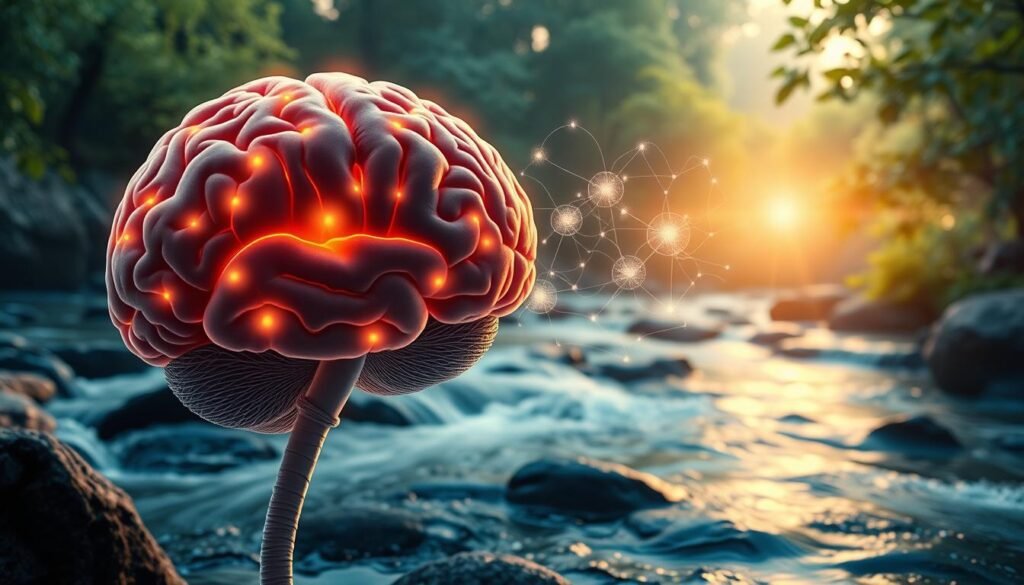Mindfulness Workflow: Enhance Focus and Efficiency
Let’s face it: modern life throws endless distractions your way. Emails ping, deadlines loom, and your brain constantly races. What if you could rewire your daily habits to stay calm and productive? That’s where a mindful approach to work comes in.
This isn’t about sitting cross-legged for hours. It’s training your mind to anchor itself in the now. By gently guiding your attention back to the present, you create mental clarity. Think of it like a muscle—the more you practice, the stronger your focus becomes.
You’ll learn simple methods to build this skill into your routine. Whether you’re juggling Zoom calls or household chores, small shifts can reduce stress and boost efficiency. We’ll break down science-backed strategies that fit any schedule.
Key Takeaways
- Transform daily tasks by anchoring your awareness in the present moment
- Reduce mental clutter with easy techniques that take seconds to implement
- Design a personalized system that works for your unique responsibilities
- Strengthen decision-making skills by pausing before reacting
- Balance productivity with self-care using intentional breathing exercises
Understanding the Power of Mindfulness
Ever notice how your best ideas come when you’re fully engaged in an activity? That’s presence in action. True awareness means catching yourself when thoughts drift to yesterday’s meeting or tomorrow’s to-do list—and gently steering back to what’s happening right now.

The Role of Presence in Daily Life
Presence turns ordinary moments into opportunities. Instead of rushing through lunch while checking emails, try tasting each bite. Notice textures, flavors, and how your body feels. This simple shift helps rewire your brain to focus better during important tasks.
Impact on Relationships and Overall Health
When you give someone your full attention, conversations deepen. Research shows people feel more valued when you make eye contact instead of glancing at screens. Health-wise, regular awareness practice lowers cortisol levels and improves sleep quality—no fancy equipment needed.
Mindfulness vs. Multitasking
Here’s the truth: juggling three tasks at once often means doing all three poorly. Single-tasking with full awareness leads to fewer mistakes. One study found workers who focused on one project at a time completed tasks 23% faster than chronic multitaskers.
“Attention is the rarest and purest form of generosity.”
Building this skill takes practice, but the rewards ripple through every part of life. Start small—maybe by silencing notifications during family dinners—and watch how moments of clarity add up.
The Science Behind Mindfulness and Meditation
Neuroscience now reveals what ancient practices have long suggested: focused awareness reshapes your biology. Groundbreaking studies show measurable changes in brain structure and function after consistent practice. These findings explain why millions report feeling calmer and sharper when making this a daily habit.

Brain Benefits and Cognitive Improvements
A 40-day study with new meditators showed increased gray matter in areas managing emotions. Long-term practitioners? Their brains age slower. Think of it like a mental gym—regular sessions strengthen focus and decision-making skills.
| Brain Change | Meditators | Non-Meditators |
|---|---|---|
| Gray Matter Density | +8.1% | No Change |
| Annual Tissue Loss | -0.3% | -0.7% |
| Focus Duration | 22% Longer | Baseline |
Stress Reduction Mechanisms
When stress hits, your body’s calm-down system kicks in faster with practice. Research shows anxiety levels drop as effectively as some medications. Bonus? Better sleep and stronger immunity often follow.
One study found cortisol (the stress hormone) decreased by 14% in eight weeks. Participants also reported fewer headaches and improved digestion. Your breath becomes a remote control for your nervous system—inhale calm, exhale tension.
“The mind can be trained just like muscles—through repetition and intention.”
Simple Mindfulness Exercises for Daily Practice
Discover how everyday actions can become gateways to calm and concentration. These practical methods help you reconnect with the present while going about regular routines. Best part? They take less time than scrolling social media.
Breathe and Pause: Fundamental Techniques
Your breath works like an anchor during stormy days. Try this: inhale for four counts, hold for two, exhale for six. Notice how air feels cooler entering nostrils and warmer leaving. Repeat three times. This exercise resets your nervous system in under a minute.
Mindful Walking and Eating
Turn your lunch break into a sensory experience. Chew slowly, noticing textures and flavors. Put your phone face-down—each bite deserves full attention. Walking? Feel your feet pressing the ground. Notice how arms swing naturally. These activities train your brain to focus during routine tasks.
Quick Mindfulness Breaks at Work
Stuck between meetings? Try the 3-2-1 method: name three things you hear, two you feel, one you smell. Or tense-release muscles from toes to shoulders. Pro tip: Set a reminder to pause for three conscious breaths every 90 minutes. You’ll return to tasks with fresh eyes.
“The little moments of awareness add up to big changes in how we experience life.”
Consistency matters more than duration. Even two minutes daily builds mental resilience. Start with one exercise that fits naturally into your schedule—maybe mindful coffee sipping or listening to rain sounds. Progress happens through repetition, not perfection.
Creating Your Mindfulness Workflow for Focused Productivity
Your daily rhythm holds hidden moments perfect for building focus. Spot natural pauses in your schedule—like after sending an email or before a meeting—to reset your attention. These micro-pauses become launchpads for clarity.

Designing a Routine that Works
Start by tagging existing habits. Morning coffee? Savor the aroma for 30 seconds. Walking to the office? Notice five sounds around you. These anchor activities make consistency effortless.
Try this three-step approach:
- Choose two daily transitions (e.g., lunch breaks, commute)
- Attach 90-second breathing exercises to each
- Track progress with checkmarks on your calendar
Busy week? Scale to 20-second check-ins. Calm day? Expand to five-minute sessions. Flexibility prevents frustration. One study found workers who adapted their practice duration maintained routines 47% longer than rigid planners.
| Practice Time | Daily Impact | Best For |
|---|---|---|
| 2 minutes | Stress reduction | High-pressure days |
| 5 minutes | Focus boost | Creative work |
| 10 minutes | Emotional balance | Decision-heavy tasks |
“Small daily acts of awareness reshape entire weeks.”
Pair reminders with routine actions. Phone charging = posture check. Printer humming = shoulder relaxation. Soon, your environment becomes a network of focus triggers.
Mindfulness Meditation Techniques for Deep Focus
Unlock deeper concentration through meditation methods designed for modern life. Whether you’re new to these practices or refining existing skills, structured approaches can sharpen mental clarity. Let’s explore practical ways to cultivate laser-like attention.

Exploring Formal and Informal Practices
Formal meditation involves scheduled sessions focusing on breath or body sensations. Set aside 10-30 minutes daily—morning coffee time or pre-meeting moments work well. Studies show consistent practice strengthens neural pathways linked to concentration.
Informal methods turn routine actions into focus boosters. Wash dishes while noticing water temperature. Walk meetings become sensory adventures—listen to footsteps, feel air movement. These micro-practices build awareness without extra time.
Integrating Guided and Self-Practice Sessions
Apps like Headspace offer guided sessions perfect for beginners. Voice instructions help maintain attention during challenging moments. Busy professionals often prefer 7-minute audio guides between tasks.
Self-directed practice lets you personalize techniques. Try mantra repetition for 5 minutes, then switch to body scans. Advanced users blend methods—start with breath counting, transition to loving-kindness phrases. Research confirms mixed approaches enhance cognitive flexibility.
“Meditation isn’t about emptying the mind—it’s learning to direct attention with purpose.”
Experiment with styles matching your needs. Anxiety-prone? Try grounding visualizations. Night owls benefit from sleep-focused body relaxation. Track what works using a simple journal—note focus levels before/after sessions.
Practical Strategies for Incorporating Mindfulness at Work
Ever feel like your workday controls you more than you control it? Small shifts in how you approach tasks can create big changes. Let’s explore ways to stay grounded even when deadlines pile up.
Smart Breaks, Better Focus
Your brain works best in bursts. Try the 52/17 rule: work 52 minutes, then take a 17-minute mindfulness break. Walk outside or do gentle stretches. This rhythm matches your natural energy cycles, keeping your attention sharp all day.
Silence email alerts and check messages just three times daily—morning, lunch, and afternoon. Create phone-free zones during important projects. These tweaks cut stress and help you dive deeper into tasks.
Listening That Builds Trust
Next time someone speaks, try this: notice their tone and body language. Pause three seconds before replying. This judgment-free approach strengthens workplace relationships. You’ll catch details others miss.
Use your commute as a reset button. Turn off podcasts and feel the steering wheel in your hands. Notice traffic sounds without labeling them “good” or “bad.” These moments become opportunities to arrive calm and ready.
FAQ
How does being present improve daily life?
Focusing on the present moment helps reduce distractions and anxiety. It allows you to engage more deeply with tasks, conversations, and experiences, leading to better decision-making and a calmer mindset.
Can mindfulness really reduce stress?
Yes! Studies show that practices like focused breathing or body scans activate the parasympathetic nervous system, which lowers cortisol levels. Over time, this helps manage chronic stress and improves emotional resilience.
What’s a quick exercise to try during a busy workday?
Try the “5-4-3-2-1” technique: Pause and name five things you see, four you feel, three you hear, two you smell, and one you taste. This grounds you in the moment and resets your focus.
How do I start a routine without feeling overwhelmed?
Begin with just 2–5 minutes daily. Pair an existing habit—like morning coffee—with a short breathing exercise. Gradually add small practices, like mindful walking or gratitude journaling, to build consistency.
What’s the difference between guided and self-led meditation?
Guided sessions use audio or apps (like Headspace or Calm) to direct your practice, ideal for beginners. Self-led meditation involves focusing independently on breath or sensations, offering flexibility for personalized routines.
How can I stay focused in a distracting work environment?
Schedule short breaks every 60–90 minutes to reset. Use noise-canceling headphones for ambient sounds, and practice active listening during meetings to stay engaged. Small adjustments create a more intentional workflow.
Can mindful eating improve health?
Absolutely! Paying attention to flavors, textures, and hunger cues helps prevent overeating and fosters a healthier relationship with food. It also enhances digestion by reducing stress during meals.
Why is multitasking less effective than mindfulness?
Multitasking splits attention, lowering efficiency and increasing errors. Single-tasking with full awareness boosts productivity, creativity, and memory retention by allowing deeper immersion in each activity.
Share this content:




Post Comment